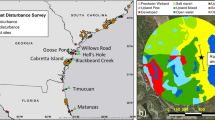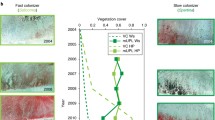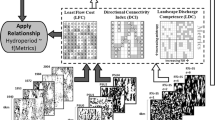Abstract
The ridge–slough landscape of the Everglades (Florida, USA), is characterized by elevated ridges dominated by sawgrass (Cladium jamaicense) interspersed among deeper sloughs dominated by floating, submerged and emergent macrophytes and calcareous periphyton. Interactions among hydrologic conditions (water depth, hydroperiod), plant composition and production, and respiration are hypothesized to create alternative peat accretion equilibria at the point scale, while spatial interactions among patches create regular pattern at the landscape scale. Despite significant research on these interactions, few studies have examined the hypothesis that the ridge–slough landscape consists of spatially coupled alternative stable patch states, and none has used diagnostic indicators thereof to assess landscape resilience to hydrologic change. Dense random sampling of water depths (a proxy for soil elevation) along a gradient of hydrologic impairment of drained to relatively natural to impounded conditions was used to evaluate four predictions related to this hypothesis: (1) bimodal soil elevation distributions show strong fidelity to community type; (2) positive autocorrelation at short distances with negative values at longer distances; (3) strong anisotropy (diagnostic of flow orientation), and spatial structure (diagnostic of the strength of landscape self-organization); and (4) loss of these features with hydrologic modification. Our results support the hypothesis that soil elevations are strongly bimodal and anisotropic in areas with minimal hydrologic impact, and spatial autocorrelation patterns indicate the operation of scale-dependent feedbacks. These metrics change markedly with hydrologic modification, although with differences between drainage and impoundment. Moreover, changes in landform precede associated changes in vegetation, suggesting their utility as diagnostic indicators of landscape degradation and recovery.






Similar content being viewed by others
References
Armentano TV, Sah JP, Ross MS, Jones DT, Cooley HC, Smith CS. 2006. Rapid responses of vegetation to hydrological changes in Taylor Slough, Everglades National Park, Florida, USA. Hydrobiologia 569:293–309.
Baldwin M, Hawker HW. 1915. Soil survey of the Fort Lauderdale area, Florida. In: Field operations of the Bureau of Soils, 1915. U.S. Department of Agriculture. pp 751–98.
Bazante J, Jacobi G, Solo-Gabriele HM, Reed D, Mitchell-Bruker S, Childers DL, Leonard L, Ross M. 2006. Hydrologic measurements and implications for tree island formation within Everglades National Park. J Hydrol 329:606–19.
Belyea LR, Clymo RS. 2001. Feedback control on the rate of peat formation. Proc R Soc Lond B 268:1315–21.
Bernhardt CE, Willard DA. 2009. Response of the Everglades ridge and slough landscape to climate variability and 20th century water management. Ecol Appl 19:1723–38.
Brewer JS. 1996. Site differences in the clone structure of an emergent sedge, Cladium jamaicense. Aquat Bot 55:79–91.
Busch DE, Loftus WF, Oron LB, Jr. 1998. Long-term hydrologic effects on marsh plant community structure in the southern Everglades. Wetlands 18:230–41.
Childers DL, Doren RF, Jones R, Noe GB, Rugge M, Scinto LJ. 2003. Decadal change in vegetation and soil phosphorus pattern across the Everglades landscape. J Environ Qual 32:344–62.
Cohen MJ, Osborne TZ, Lamsal SJ, Clark, M. 2009a. Regional distribution of soil nutrients—hierarchical soil nutrient mapping for improved ecosystem change detection. SFWMD Report. 91 p.
Cohen MJ, Watts DL, Heffernan JB, Osborne TZ. 2010. Reciprocal biotic control of hydrology, nutrient gradients and landform in the Greater Everglades. Crit Rev Environ Sci Technol (in press).
Conrads PA, Roehl EA, Jr. 2007. Hydrologic record extension of water-level data in the Everglades Depth Estimation Network (EDEN) using artificial neural network models, 2000–2006. U.S. Geological Survey Open-File Report 2007-1350. 56 p (only online at http://pubs.water.usgs.gove/ofr2007-1350).
Craft CB, Richardson CJ. 1993. Peat accretion and N, P, and organic C accumulation in nutrient-enriched and unenriched Everglades peatlands. Ecol Appl 3:446–58.
David PG. 1996. Changes in plant communities relative to hydrologic conditions in the Florida Everglades. Wetlands 16:15–23.
Eppinga MB, Rietkerk M, Borren W, Lapshina E, Bleuten W, Wassen M. 2008. Regular surface patterning of peatlands: confronting theory with field data. Ecosystems 11:520–36.
Eppinga MB, de Ruiter PC, Wassen MJ, Rietker M. 2009a. Nutrients and hydrology indicate the driving mechanisms of peatland surface patterning. Am Nat 173:803–18.
Eppinga M, Rietkerk M, Belyea L, Nilsson M, de Ruiter P, Wassen M. 2009b. Resource contrast in patterned peatlands increases along a climatic gradient. Ecology. doi:10.1890/09-1313.
Gaiser EE, Trexler J, Richards JH, Childers DL, Lee D, Edwards AL, Scinto LJ, Jayachandran K, Noe GB, Jones RD. 2005. Cascading ecological effects of low-level phosphorus enrichment in the Florida Everglades. J Environ Qual 34:717–23.
Givnish TJ, Volin JC, Owen D, Volin VC, Muss JD, Glaser PH. 2007. Vegetation differentiation in the patterned landscape of the central Everglades: importance of local and landscape drivers. Glob Ecol Biogeogr 17:1–19.
Goovaerts P, Ed. 1997. Geostatistics for natural resources evaluation. New York: Oxford University Press. p 483.
Hagerthey SE, Newman S, Rutchey K, Smith EP, Godin J. 2008. Multiple regime shifts in a subtropical peatland: community-specific thresholds to eutrophication. Ecol Monogr 78:547–65.
Harvey JW, Schaffranek RW, Noe GB, Larsen LG, Nowacki DJ, O’Connor BL. 2009. Hydroecological factors governing surface water flow on a low gradient floodplain. Water Resour Res 45:W-3421. doi:10.1029/2008WR007129.
Jorczak E. 2006. Influence of hydrology on Everglades ridge and slough soil topography. Soil and Water Science. M.S. Thesis, University of Florida, Gainesville (FL), USA. 63 p.
Larsen LG, Harvey JW, Crimaldi JP. 2007. A delicate balance: ecohydrological feedbacks governing landscape morphology in a lotic peatland. Ecological Monographs 77:591–614.
Larsen LG, Harvey JW, Crimaldi JP. 2009. Morphologic and transport properties of natural organic floc. Water Resources Research 45:W01410. doi:10.1029/2008WR006990.
Larsen LG, Aumen C, Bernhardt V, Engel T, Givnish S, Hagerhey J, Harvey L, Leonard P, McCormick C, McVoy G, Noe M, Nungesser M, Rutchey K, Sklar F, Troxler T, Volin J, Willard D. 2010. Recent and historic drivers of landscape change in the Everglades ridge, slough, and tree island mosaic. Crit Rev Environ Sci Technol (in press).
Leeds JA, Smith SM, Garrett PB. 2002. Seedbanks and their potential rold in the vegetation dynamics of a northern Everglades marsh. Florida Scientist 65:16–34.
Legendre P. 1993. Spatial Autocorrelation: Trouble or New Paradigm? Ecology 74:1659–73.
Lewis CG. 2005. Linkages among vegetative substrate quality, biomass production, and decomposition in maintaining Everglades ridge and slough vegetative communities. Soil and Water Science. M.S. Thesis, University of Florida, Gainesville (FL), USA. 58 p.
Light SS, Dineen JW. 1997. Water control in the Everglades: a historical perspective. In: Davis SM, Ogden JC, Eds. Everglades: the ecosystem and its restoration. Boca Raton (FL): St. Lucie Press. pp 47–84.
Loveless CM. 1959. A study of the vegetation in the Florida Everglades. Ecology 40:9.
Ludwig JA, Tongway DJ, Marsden SG. 1999. Stripes, stands, or stipples: modelling the influence of three landscape banding patterns on resource capture and productivity in semi-arid woodlands, Australia. Catena 37:257–73.
McVoy CW, Said WP, Obeysekeran J, Arman JV, Dreschel TW. 2010. Landscapes and hydrology of the pre-drainage Everglades. Gainesville, FL: University Press of Florida (in press).
Pezeshki SR, DeLaune RD, Kludze HK, Choi HS. 1996. Photosynthetic and growth responses of cattail (Typha domingensis) and sawgrass (Cladium jamaicense) to soil redox conditions. Aquat Bot 54:25–35.
Rietkerk M, Dekker SC, de Ruiter PC, van de Koppel J. 2004a. Self-organized patchiness and catastrophic shifts in ecosystems. Science 305:1926–9.
Rietkerk M, Dekker SC, Wassen MJ, Verkroost AWM, Bierkens MFP. 2004b. A putative mechanism for bog patterning. Am Nat 163:699–708.
Rietkerk M, van de Koppel J. 2008. Regular pattern formation in real ecosystems. Trends Ecol Evol 23:169–75.
SCT. 2003. The role of flow in the Everglades ridge and slough landscape. Science Coordinating Team, Miami (FL): South Florida Ecosystem Restoration Working Group.
SFWMD. 1992. Surface water improvement and management plan for the Everglades: supporting information document. West Palm Beach (FL): South Florida Water Management District.
Sklar FH, Coronado-Molina CA, Gras A, Rutchey K, Gawlik DE, Crozier G, Bauman L, Hagerthy S, Shuford R, Leeds JA, Wu Y, Madden CJ, Garrett PB, Nungesser M, Korvela M, McVoy C. 2004. Ecological effects of hydrology. Everglades Consolidated Report. West Palm Beach (FL): South Florida Water Management District. pp 6–58.
Smith SM, McCormick PV, Leeds JA, Garrett PB. 2002. Constraints of seed bank species composition and water depth for restoring vegetation in the Florida Everglades, USA. Restor Ecol 10:138–45.
Suding KN, Gross KL, Houseman GR. 2004. Alternative states and positive feedbacks in restoration ecology. Trends Ecol Evol 19:46–53.
Vaithiyanathan P, Richardson CJ. 1998. Biogeochemical characteristics of Everglades sloughs. J Environ Qual 27:1439–50.
van de Koppel J, Crain CM. 2006. Scale dependent inhibition drives regular tussock spacing in a freshwater marsh. Am Nat 168:E136–47.
Walters C, Gunderson L, Holling CS. 1992. Experimental policies for water management in the Everglades. Ecol Appl 2:189–202.
Weisner SEB, Miao S. 2004. Use of morphological variability in Cladium jamaicense and Typha domingensis to understand vegetation changes in an Everglades marsh. Aquat Bot 78:319–35.
Wu Y, Sklar FH, Rutchey K. 1997. Analysis and simulations of fragmentation patterns in the Everglades. Ecol Appl 7:268–76.
Wu Y, Wang N, Rutchey K. 2006. An analysis of spatial complexity of ridge and slough patterns in the Everglades ecosystem. Ecol Complex 3:183–92.
Zafke M. 1983. Plant communities of water conservation area 3A; baseline documentation prior to the operation of S-339 and S-340. Technical Memorandum DRE-164. West Palm Beach (FL): South Florida Water Management District. pp 1–31.
Zweig CL, Kitchens WM. 2008. Effects of landscape gradients on wetland vegetation communities: information for large-scale restoration. Wetlands 28:1086–96.
Acknowledgments
We are indebted to Elizabeth Deimeke, Jason Evans, Dina Liebowitz, Tae-goo Oh, Laura Schreeg, Lauren Long, Justin Vogel, and Adam Watts for field support, and to Sanjay Lamsal for advice on spatial analyses. This manuscript benefited greatly from comments by Maarten Eppinga, Donald DeAngelis, and Laurel Larsen. We acknowledge the support of MAP-RECOVER and the US Army Corps of Engineers through grants to the University of Florida.
Author information
Authors and Affiliations
Corresponding author
Additional information
Author contributions
DLW conceived of study, performed research, analyzed data, contributed to writing of paper. MJC conceived of and designed study, analyzed data, contributed to writing of paper. JBH performed research, contributed to writing of paper. TZO conceived of and designed study.
Rights and permissions
About this article
Cite this article
Watts, D.L., Cohen, M.J., Heffernan, J.B. et al. Hydrologic Modification and the Loss of Self-organized Patterning in the Ridge–Slough Mosaic of the Everglades. Ecosystems 13, 813–827 (2010). https://doi.org/10.1007/s10021-010-9356-z
Received:
Accepted:
Published:
Issue Date:
DOI: https://doi.org/10.1007/s10021-010-9356-z




